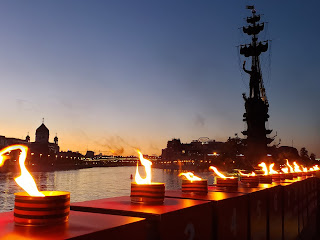At the beginning of June the city of Moscow created an official schedule, allowing residents outside to go for walks and/or exercise on specific days for the first half of the month. Until then, all of us (except essential workers, of course,) were supposed to stay home.
From mid March until the end of May, we were allowed out only to walk to our nearest grocery store or pharmacy, to take out rubbish, or to walk a dog within 100 meters of home. For most people, this meant very little walking, as there are grocery stores and pharmacies in every neighborhood, on many blocks.
I was thrilled to have official permission to go outside for walking and exercising. Each building was given specific days for walking, I walked as much as I could. At that point, I didn't care if Google maps said it would take me two hours to get somewhere, I was all in.
And usually when Google maps says it will take me two hours to walk somewhere, I'll take three hours, because I stop so often for photos.)I went from taking 500-1000 steps a day for more than two months to taking 20,000-25,000 steps a day, which wore me out at first but also felt really really good.
I walked to a few historical train stations around the city. I walked to churches. I walked to parks. I walked to a building decorated in 'Chinese' style. I walked along Moscow River in both daytime and after dark. I walked to several monasteries. I walked to a couple Lenin statues. I walked to various buildings with grafitti murals.
I walked to Red Square, which is even more impressive than normal when it isn't chock full of tourists. I was able to take a photo of St. Basil's Cathedral without anyone else in the photo. I walked in the central neighbourhood of Arbat. I found heaps of supermarkets I hadn't known about previously. I walked to a number of war memorials.
I walked to a fancy bridge, one that has a restaurant hanging under the peak of the arch, over the roads below. I walked to apartment blocks with huge faces/people painted on them. I walked to the victory arch in Park Pobedy.
I suppose I could've summed up the first half of June by saying this: I walked.
Once the digital pass system was stopped, I started riding the metro again. (Wearing a mask, of course.) I worked all the way through the end of the month, but my work from home schedule gave me more free time, so I went further around the city. (Always wearing a mask in public indoor places.)
One day I was heading for an Orthodox Church when I spotted Buddhist prayer flags. I ended up skipping the church and visiting a stupa instead. Much more interesting, and much more unique. Curiously, there was a mosque not too far away. Most of Russia is Orthodox, but other religions are represented all over the country.
One day I rode the metro to VDNKh, walking all over the area. City workers had been kept busy during this time, everything was super CLEAN. I went back to the ecowalk I'd first seen in October, and took more photos. (It looks much better without other people ;)
Another day I went to 'new' metro stations, they'd been officially opened the first week I worked from home. As usual, each station was decorated differently, all of them interesting. If I remember correctly, Moscow now has more than 250 metro stations, and the system is still being expanded.
A few days I went to a beach. Definitely not a pretty beach, but being outside and in the warm sun felt good. Like so many others, I was probably lacking in vitamin D during months of staying home/indoors.
Near the end of June, I learned about a war memorial event about to take place along the banks of the Moscow River not far from Gorky Park. During the event a small flag was hung along the banks of the river for each day of WW2. (According to the official count by Russia.) There were 1418 flags, each accompanied by a candle. The candles were lit just before sunset, making the whole thing really photogenic. I don't know for sure if this memorial takes place every year, but I imagine it does. I just need to figure out if the June day is normal, or whether it is also a normal May event.
Due to the pandemic, this year's Victory Day tank parade was postponed from 9 May to 24 June. It turns out that 24 June was the anniversary of the first ever Victory Parade in Moscow, so the specific date made sense. Even though the pandemic was still very much happening, and there were supposed to be restrictions about big gatherings, all that seemed to go out the window for the parade.
There were several dress rehearsals in the days before the parade, I was able to see them from my balcony and the streets nearby. Very cool, though I didn't love all the people standing around to watch. At that point I was normally wearing a mask only when indoors in a public space, but when I was on the street for parade rehearsals I wore the mask then too.
June was certainly an interesting month this year. Though I was happy to walk all over Moscow, I'd much rather have a 'normal' June next year and foreva after.









































